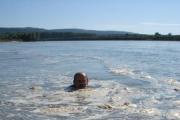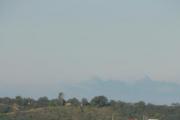
On Thursday (Sept.13), the ships crossed into Bulgarian waters and were able to complete sampling at Stations 64 at the Iron Gate II, pass through its lock, and continue to Station 65 (Upstream Timok River) and 66 (Timok), but not without challenges.
The entire day was marked by fierce winds and waves. This made sampling from the small boat very difficult, especially near the concrete bank where large waves hurled the boat against the wall. Air-lift sampling also proved difficult because the Argus could not be stabilized by anchor in the deep water (about 11 meters) near the Iron Gate II dam. The Argus's submerged pump also went out of order all day, thereby stopping the continuous flow of river water to the lab and making impossible many of the standard tests including Radon measurement. This was despite the extensive efforts of Argus technician Tomislav Andjic and JDS2 Core Team member Richard Niederreiter. Even so, the day ended with an optimistic mood.
On Friday the 14th, the day began with the team absorbing a beautiful sunrise and, a little later, a nice song blown from the Széchenyi horn - "Frére Jacques. Frére Jacques. Dormez-vous? Dormez-vouz?..." - to get the Argus team going.
After crossing into Romanian waters, the team went on to sample Station 67 in the Novo Selo harbour. There, the team was also welcomed by two Bulgarian friends: Mihail Mollov, a former member of an ICPDR Expert Group, and Boyan Boyanovski, former member of the JDS1 Core Team. After sampling at Station 68 in Calafat, the trip to Lom, Bulgaria, took about three hours, giving team members time to either relax and enjoy the landscape, or catch up on work.
Reaching Lom, the JDS2 met the Bulgarian National Team and handed them containers for sampling the Iskar tributary. At the same time, fish samples on-board the Széchenyi were sent out for analysis. The evening ended with preparation of a nice JDS2 cake cooked by three enthusiastic team ladies.
Macrozoobenthos highlights
The highlights from Saturday the 15th were a number of interesting macrozoobenthos finds. One was the small, delicate and very rare snail Theodoxus transversalis. Hungarian specialist Bela Csanyi, who has investigated the Danube for nearly his entire life, had not found a living specimen of this snail over the last decade.
Having carefully rinsed large amounts of sandy material collected from the air-lift sampler, the macrozoobenthos team also found an unidentifiable Crustacean that was completely white, with small eyes, apparently adapted to dig in sandy substrates. Its identity will be checked later.
Among the most interesting species found so far were dragonflies of the genera Gomphus and Ophiogompus which are indicators of good natural conditions for river bed dynamics. Overall, the dominating species found was the mollusc Corbicula fluminea which covers the bottom in huge masses. "With an amazing biomass that can reach several kilograms per square meter, this organism is the real queen of the Danube," says Csanyi.
Macrozoobenthos samples were taken by the Argus air-lift sampler at depths of between four and 11 meters, from substrates including sand, gravel and stone. In parallel, samples are also taken using a ‘kick-and-sweep' method whereby a scientist wades backwards in the water while kicking the bottom and catching what rises up in a net in front of him. Afterwards, organisms are identified under a microscope in the Argus lab. It being the first time an air-lift sampler was used for Danube sampling, scientists are curious to find out how the ‘air-lift' and ‘kick-and-sweep' results will compare later on, once all the results are in.





















